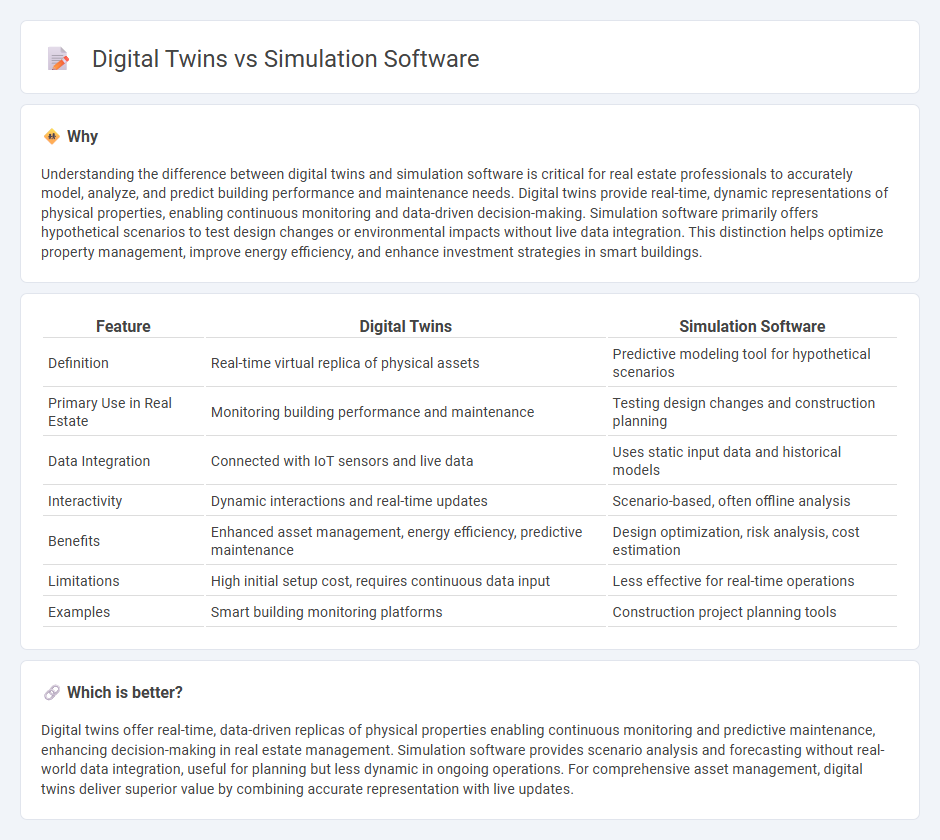
Digital twins create real-time, dynamic replicas of physical properties by integrating IoT data, enabling precise facility management and predictive maintenance. Simulation software models various real estate scenarios, such as market trends and structural performance, supporting strategic decision-making and risk assessment. Explore the differences between digital twins and simulation software to enhance your real estate investment and management strategies.
Why it is important
Understanding the difference between digital twins and simulation software is critical for real estate professionals to accurately model, analyze, and predict building performance and maintenance needs. Digital twins provide real-time, dynamic representations of physical properties, enabling continuous monitoring and data-driven decision-making. Simulation software primarily offers hypothetical scenarios to test design changes or environmental impacts without live data integration. This distinction helps optimize property management, improve energy efficiency, and enhance investment strategies in smart buildings.
Comparison Table
| Feature | Digital Twins | Simulation Software |
|---|---|---|
| Definition | Real-time virtual replica of physical assets | Predictive modeling tool for hypothetical scenarios |
| Primary Use in Real Estate | Monitoring building performance and maintenance | Testing design changes and construction planning |
| Data Integration | Connected with IoT sensors and live data | Uses static input data and historical models |
| Interactivity | Dynamic interactions and real-time updates | Scenario-based, often offline analysis |
| Benefits | Enhanced asset management, energy efficiency, predictive maintenance | Design optimization, risk analysis, cost estimation |
| Limitations | High initial setup cost, requires continuous data input | Less effective for real-time operations |
| Examples | Smart building monitoring platforms | Construction project planning tools |
Which is better?
Digital twins offer real-time, data-driven replicas of physical properties enabling continuous monitoring and predictive maintenance, enhancing decision-making in real estate management. Simulation software provides scenario analysis and forecasting without real-world data integration, useful for planning but less dynamic in ongoing operations. For comprehensive asset management, digital twins deliver superior value by combining accurate representation with live updates.
Connection
Digital twins create precise virtual replicas of real estate properties, enabling simulation software to analyze and forecast building performance, energy consumption, and structural integrity. This integration enhances property management by allowing stakeholders to identify potential issues and optimize maintenance strategies in real time. The synergy between digital twins and simulation software drives smarter, data-driven decision-making in the real estate sector.
Key Terms
Virtual Modeling
Simulation software creates virtual models to analyze complex systems by replicating real-world behaviors through mathematical algorithms and physics-based calculations. Digital twins extend virtual modeling by integrating real-time data from physical assets, enabling continuous synchronization and dynamic system optimization. Discover more about how virtual modeling evolves from simulation software to digital twins for enhanced decision-making and innovation.
Real-time Data Integration
Simulation software models complex systems using predefined parameters, but often relies on static or historical data inputs that limit real-time responsiveness. Digital twins integrate real-time data streams from IoT sensors and connected devices to continuously update virtual models, enabling dynamic decision-making and predictive analytics. Explore how real-time data integration transforms operational efficiency by bridging simulation software and digital twin technologies.
Scenario Analysis
Simulation software enables scenario analysis by creating mathematical models to predict outcomes under varied conditions, optimizing decision-making in industries such as manufacturing and healthcare. Digital twins extend this capability by integrating real-time data from physical assets, allowing dynamic scenario testing and continuous performance monitoring. Explore how combining simulation software with digital twins can revolutionize scenario analysis for your organization.
Source and External Links
SimScale - A cloud-based CAE simulation software for CFD, FEA, and thermal simulations, integrating AI for enhanced design decisions.
Simulation Software - Programs that model real-world phenomena using mathematical formulas to simulate operations without actual execution.
AnyLogic - A leading simulation software allowing multimethod modeling for complex business systems across various industries.
 dowidth.com
dowidth.com